This is an Olympus Pen EE-S, a 35mm half frame camera made by Olympus Optical Co., Ltd. between the years of 1962 and 1966. As with all cameras from Olympus’s Pen series, these are compact half frame cameras that shoot 18x24mm “half frame” images on normal 35mm film. The EE series incorporated an exposure meter and automatic exposure, making it one of the first true “point and shoot” amateur cameras. The EE-S variant upgraded the original EE model with adjustable focus and a faster 3cm f/2.8 lens. As with all cameras from the Olympus Pen series, these were well built, compact, but simple cameras that offered economy through their half frame sized photos, and great optics with their quality D.Zuko lenses.
Film Type: 135 (35mm) 18mm x 24mm Half Frame
Lens: 30cm f/2.8 Olympus D.Zuiko coated 4-elements
Focus: 90cm (3 feet) to Infinity with Click Stops for Close, Group, and Scene
Viewfinder: Scale Focus with 3cm Projected Frame Lines
Shutter: 2 Speed Leaf
Speeds: 1/40 and 1/200 seconds
Exposure Meter: Coupled Selenium Cell w/ Viewfinder Underexposure Warning Indicator
Battery: None
Flash Mount: Coldshoe and PC-port Flashbulb Sync
Weight: 375 grams
Manual: http://www.cameramanuals.org/olympus_pdf/olympus_pen_ee-s.pdf
How these ratings work |
The Olympus Pen EE-S was neither the first, last, best, or worst model in the entire half frame Pen range, but it’s biggest strength is in how well rounded it is. The build quality of the camera is outstanding, it has an optically excellent 4-element lens with complete manual control over exposure, but the added convenience of a match needle exposure meter. It’s fun to use, and extremely compact. When it comes to finding the best compromise of a classic point and shoot camera, the EE-S represents a very rare balance of everything you could possibly want. | ||||||
| Images | Handling | Features | Viewfinder | Feel & Beauty | History | Age | |
| 2 | 2 | 1 | 1 | 2 | 1 | 20% | |
| Bonus | +1 for the complete package, this camera checks all the right boxes with very little that could be improved | ||||||
| Final Score | 11.8 | ||||||
History
Oskar Barnack, August Nagel, Walter Dorwin Teague, and Masahiko Fuketa are all names that come to mind when thinking of influential camera designers of the 20th century. Without them, we may not have Leicas, Retinas, Bantam Specials, or the Nikon F today.
While each of these four men have earned their places as great designers, there is another man who is just as deserving to be spoken of with the same level of regard.
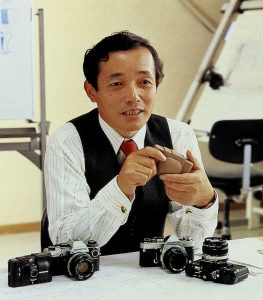
Yoshihisa Maitani was born January 8, 1933 in Kagawa Prefecture, Shikoku, Japan, and was the youngest son of a rice wine and soy sauce maker. Young Maitani had an interest in cameras, building his own rudimentary design at the age of 10 but when he attended college at Tokyo’s Waseda University, he pursued a degree in mechanical engineering and specialized in automobile engines. While studying in school it is said that Maitani took many photographs with a Leica IIIf which he loved, but found it to be limiting in closeup work. When he would encounter a situation in which the Leica wasn’t ideal for the type of photograph he wanted, he came up with designs of cameras that would meet his needs. In his free time, Maitani designed a unique new camera which he applied a patent for, although had no intention of ever putting it into production.
After college, Maitani got a job working for an automobile company, but a chance encounter by Eiichi Sakurai, a noted camera designer and Director of the camera development division of Olympus Optical Co. Ltd., who discovered the patent filed for by Maitani and was so impressed, in 1956, he persuaded him to come work for Olympus.

For the first two years, Maitani worked in the camera design department working on small projects the company already had begun working on, but in 1958 was given his own assignment to design an all new and inexpensive camera that could be built and sold for no more than 6000 Yen. This was an ambitious goal as the next cheapest camera in Olympus’s lineup at the time cost 23,000 Yen. Converting historical international currencies to current US dollars is often very difficult, but according to the the currency converter at historicalstatistics.org, 6000 yen in 1956 is equal to about $129 today. Other than the targeted price, the only other guideline given to Maitani was that the camera couldn’t be a toy. It had to be a quality camera that lived up to Olympus’s reputation.
Maitani was up to the challenge and approached the design of his new camera from the perspective he shared while shooting with his Leica. He thought the camera should be an extension of the photographer. It should be small and easy to use, so that the photographer did not have to bother himself with confusing controls. He thought the camera should be secondary to the photographic process. Early on, the design of the body of the camera was given to a third party industrial designer. Unhappy with the early mock ups of the camera, Maitani took over full design himself.
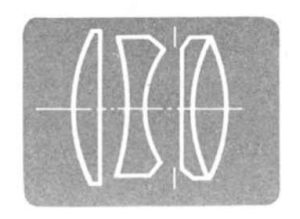
A second priority to the design and use of the camera would be it’s lens. Although the targeted price point he was working with suggested a cheap single or double element lens, Maitani wanted something better. He aimed for something comparable to a 4-element Zeiss Tessar. Maitani convinced Olympus lens designer Yoshisada Hayamizu to create an all new compact wide angle lens that would meet both the camera’s quality and financial goals.
Cost was a major factor in designing the camera. Nearly the entire budget for the camera was put into it’s lens, so Maitani had to get creative with the rest of the camera. Things like the wind lever were simplified with a knurled plastic wheel that protruded out of the back of the camera. The body needed to be small and built with clean lines and a lack of clutter. The decision to make the new camera shoot 18x24mm “half frames” was born out of the need to make the camera as compact as possible. A smaller camera meant less parts and less money to build it. As a side benefit, shooting half frames meant a photographer would get double the amount of exposures per roll. Japan’s economy had not completely recovered from the war, and the cost of film and developing was high, so doubling exposures from a single roll would have been a huge benefit.
The decision of releasing a new half frame 35mm camera was very controversial. Although half frame 35mm cameras were common in the early parts of the 20th century, they had fallen out of favor by the end of the war. In 1958 when this camera was being designed, there were no other half frame 35mm cameras being produced anywhere in the world. The success or failure of this new model would largely hinge on whether or not people would accept a new half frame camera.
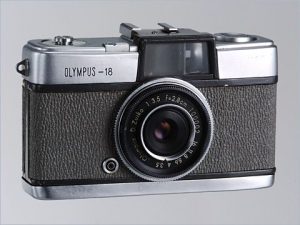
Over the next several months, Yoshihisa Maitani worked tirelessly on his new camera. He worked over time at work and even did some of the design at home. Olympus was already a respected Japanese optics company and Maitani was still a relative newcomer. His 6000 Yen project was considered low priority within the company and as a result, few people took notice of what he was doing, so he was largely free to do whatever he wanted with little oversight.
By the time Maitani was ready to reveal his camera to senior members of the company, he had built 5 prototypes to show off what he had been working on. Upon seeing the new prototypes, his superiors were hugely impressed with not only the design of the camera, but what Maitani was able to accomplish at such a meager price point. No one at the company took a 6000 Yen camera seriously, especially one designed by a junior employee, yet here was a camera with good looks, great ergonomics, and a very capable lens.
When it came time to release the camera in October 1959, the camera was given the name “Pen” as it was supposed to fit in a shirt pocket in the same place where an engineer might keep a pen. Despite excitement generated by the new camera, leadership at Olympus still considered the camera a novelty and refused to built it themselves, instead outsourcing production of the camera to a third party called Sanko Shoji. From a lecture given by Maitaini in October 2005 about the development of the Pen, he says:
…my prototype was about to go into production, and I was excited. But even though the decision to produce my camera had come from the very top, the factory manager refused to manufacture my “toy camera.” Half-size cameras didn’t exist then, and sales executives told us that my camera wouldn’t sell because there was no market for it.
Accepted wisdom told us that the camera couldn’t be made and wouldn’t sell. Since our factory wouldn’t make it, we decided to outsource production. That was how the Pen first came into being. And as soon as it went on sale, it became a best-seller…
The Pen was an immediate success selling over 30,000 units in the first couple of months of production. Due to the huge demand for the camera, Olympus took over production in early 1960 and started to expand on the Pen product line with more advanced models.
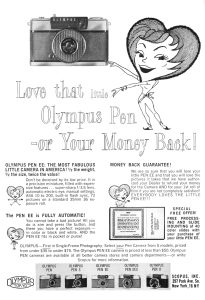
Over the course of the next few years, a huge number of Pen cameras were released, some with faster f/2.8 lenses, some with wide angle lenses, and eventually some with light meters and automatic exposure. The first metered Pen was the Pen EE from 1961. It featured a coupled selenium light “electric eye” meter that allowed the camera to automatically expose images. It was aimed at the entry level photographer with fixed focus and no manual controls, but the very next year, an upscale model called the EE-S was released which added manual aperture settings, a focusing lens, and a faster 30mm f/2.8 lens. I was unable to find any pricing information about how much the EE-S might have sold for when it was new, but the ad to the right from May 1963 suggests it’s price was between $50 and $75.
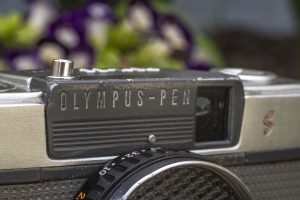
The Pen series was enormously successful and elevated Yoshihisa Maitani at Olympus as an innovative and talented designer. In the years after the original Pen’s release, Maitani was given additional projects including the Pen-F SLR, the Olympus M1 SLR (later the OM-1), and the Olympus XA. Cameras within the Pen series continued to be produced into the early 1980s, at which time the market transitioned to compact point and shoot models.
On July 30, 2009, Yoshihisa Maitani would pass away, but his mark on the company would continue as that same year, Olympus would introduce a new line of digital point and shoot cameras known as the Pen using the micro 4/3rds system, a line that they still produce to this very day.
Today, the Olympus Pen series remains a popular choice for collectors. It inspired a re-birth of half frame cameras in Japan and around the world with models being produced by nearly every company in the world. The Pen-F SLR, original Pen, and the “S” models are somewhat more collectible due to their better lenses and full manual controls, but any Pen in good working condition will likely attract attention from most collectors. Prices generally remain low for most models, so if you find a bargain on a working example, it is absolutely worth picking up.
My Thoughts
As my collection grows, the number of “accidental acquisitions” grows. These types of cameras often come as extra pieces in a lot where you were purposely buying something else. Sometimes you show up to work one day and a co-worker says “you like old cameras, right” and hands you some dusty package they found in their great-aunt’s ex-neighbor’s dog-walker’s closet.
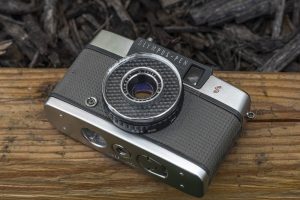
In the case of this Olympus Pen EE-S, it came as a bonus camera in a lot with last week’s Miranda Sensorex. There were a few other bonus cameras like a Brownie Target Six-16 and some cheap 126 Instamatic. The EE-S was in really terrible shape. It was dirty, the filter ring was badly dented and scratched up, and some previous owner had taped some kind of exposure cheat sheet to the film door which had darkened into a yellow gooey mess. I had come across another Pen EE (I think it was the EE-2) a couple of years back and not only did it not work, I was underwhelmed by it’s basic feature set and complete lack of manual controls.
I had absolutely no interest in the Pen EE-S until I decided to make an effort to clean it up. Like the children’s story “The Ugly Duckling”, what looked to be a nasty old duckling of a camera, turned into a beautiful swan. The shutter worked great, the meter responded to light, and the film transport had no issues. After digging into the camera’s features and knowing that it had a limited amount of manual control, I knew this was a camera I’d have to shoot.
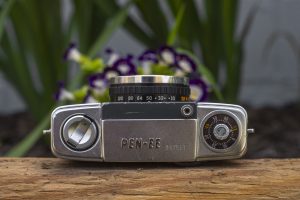
The top plate of the camera is quite simple. From left to right is a slightly recessed flip up rewind lever, a threaded shutter release, and an exposure counter. As with all models in the Pen-series, this camera shoots 18x24mm half frames, so the counter goes all the way up to 76 exposures. A normal 36 exposure cassette is generally good for 72 exposures, but sometimes you can eek out a few bonus exposures on the leader or trailer of the film. Otherwise, the only other thing on the top plate is an attractive “Pen-EE” logo and the camera’s serial number. Visible when looking at the top of the camera are either the film ASA settings or aperture f/stops, depending on the mode the camera is in.
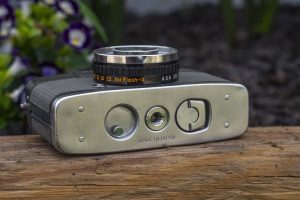
Flip the camera over and there is the rewind release button, 1/4″ tripod socket, and flip out door release lock. The screw threads for the tripod socket are part of the bottom of the camera and are not integrated into the main body of the camera. This means that care should be taken when the camera is on a tripod as the thin steel of the bottom plate is all that’s holding the camera to the mount.

Loading film into the Pen EE-S requires removing the entire back of the camera. With the back off, loading film is very easy. A new cassette goes on the left, and the leader is attached to the multi-slotted fixed take up spool on the right. The compact size of the camera means less of the film leader is wasted when loading a fresh roll, which has the benefit of getting a few bonus exposures on a roll. Although I do not recommend loading in a 36 exposure roll of film into a half frame camera as it will take you forever to finish, doing so would let you get the most out of the camera’s 76 count exposure counter!
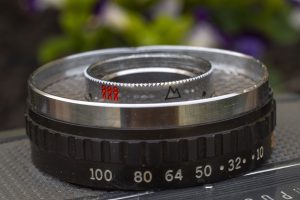
The most critical controls of the camera are all visible on top of the shutter. First is a black ring with ASA film speed numbers 10 – 200 for use in Automatic mode, or f/stops 2.8 – 22 for manual control.
Also visible on an inner chrome ring around the actual lens are three focus distance icons for Close, Group, and Scene. These three settings are used for what’s called ‘zone focus’ which a concept that was very popular in the 60s and 70s with inexpensive cameras targeted at amateurs. Rather than incorporate a focus aide like a rangefinder, the use of a semi wide angle lens that maximizes depth of field allowed for focus settings in one of three zones. They are:
- Close – For portraits, focus set to 4 feet (1.2m)
- Group – For large groups of people, focus set to 10 feet (3m)
- Scene – For landscapes, focus set to 50 feet (15m)
The whole point of a zone focus system was to simplify focusing for the beginner. While Olympus published a full depth of field table in the camera’s manual (seen below), by using a smaller f/stop and one of those three settings, you could just approximate your focus and your images would still come out sharp.
Looking at the table below, using the Group setting, with the f/stop set to f/5.6, everything from about 4.8 feet to infinity would be in focus. Using the Close setting and an f/stop of f/11, everything from 2.2 feet to 21.7 feet would be in focus. Using just these two settings likely is good enough for even the most novice photographer to consistently get in-focus photographs no matter what they wanted to point the camera at.
 Despite the excess of information I’ve provided, the Pen EE-S was designed to be a compact and easy to use camera, which it absolutely is. The mere fact that you have the additional control of manual settings and a faster lens just sweetens the deal, but without it, this camera was certainly something that anyone could shoot without having to be concerned with the technical details of photography.
Despite the excess of information I’ve provided, the Pen EE-S was designed to be a compact and easy to use camera, which it absolutely is. The mere fact that you have the additional control of manual settings and a faster lens just sweetens the deal, but without it, this camera was certainly something that anyone could shoot without having to be concerned with the technical details of photography.
Although there were many other half-frame 35mm options out there, the excellent design of the camera, combined with the excellent optics of the D.Zuiko lens, the Pen EE-S was a very capable photographic tool. I stated earlier that when I acquired this camera, it was in a lot of other things that I wanted more and that I initially dismissed it. It didn’t take long however, before I realized that this wasn’t a camera to be dismissed and that I’d have to give it a more serious look.
My Results
As I often do when shooting a new half frame camera, I usually shoot a 12 exposure roll of film in my film supply drawer. For the EE-S, I chose the last roll of expired Polaroid 200 that I had in my inventory. I’ve used this film before to great success in my reviews for the Agat 18K and the Penti II. I know the film benefits from about a half stop of over exposure from it’s box speed, and has natural to life colors. I loaded the film into the camera and set the film speed dial to 160 to compensate slightly for the age of the film and took it with me on a trip to Brookfield Zoo, near Chicago.
I threw caution to the wind with this camera and left it in automatic mode for every exposure. The shutter only has two speeds, and it selects an appropriate f/stop and shutter speed combination based on a fixed exposure program. Your only indication of proper exposure is the absence of a red flag in the viewfinder that tells you the lighting is too dark.
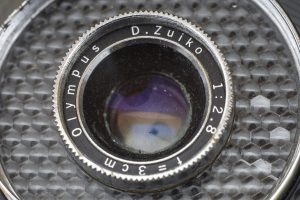
Not only was the 57 year old selenium exposure meter still working correctly, but the 4 element D.Zuiko lens performed marvelously. One of the pitfalls of some half frame cameras is that by using half of a normal 24x36mm piece of film you effectively have half of the detail in your exposure. This is the analog version of using a digital camera with half the pixels.
As they have with their entire Pen series, Olympus was wise to give these cameras very sharp lenses that are capable of eliminating the loss of detail that a half frame image might have with a lesser lens. I don’t know that I would enlarge these negatives to 16×20, but I absolutely believe they would look great at 8×10 or even 11×14.
Above is a gallery of 15 of the 24 images I got from that first roll. The only reason I didn’t share the whole roll is the rest were duplicates or slight variations of other pics above. As you can see, sharpness is excellent in all of the images. Other than a couple small light leaks that I failed to correct, the images came out great with no noticeable optical anomalies characteristic of lesser lenses.
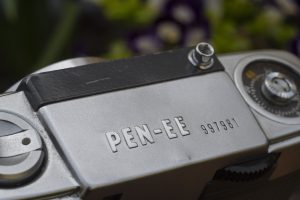
I am usually apprehensive about loading in a 24 or 36 exposure roll into a half frame camera for fear it sits partially shot, but I found that I went through the roll in this Pen very quickly. It’s compact size, decently large and bright viewfinder, and simple controls allowed me to thoroughly enjoy using the camera. Add to that the sharp D.Zuiko lens and splendid images I got from it, this camera is absolutely a winner and one of the best “ugly duckling” stories I’ve yet to come across.
I realize that many of these old selenium meter cameras have long since ‘bit the dust’ and even this camera is likely on borrowed time, but for as long as it keeps working, this will remain one of my “go to” compact cameras for family trips to the zoo. As an added bonus, the camera does allow for manual control over the iris if the meter ever should stop working which means it can still be used, unlike later Pen cameras. If you ever have an opportunity to pick one of these up, working meter or not, I highly recommend it!
Related Posts You Might Enjoy
External Links
http://camera-wiki.org/wiki/Olympus_Pen
http://www.brokencamera.club/blog/2016/6/23/olympus-pen-ees
https://www.35mmc.com/16/05/2016/fixed-perfection-olympus-pen-ee-2-guest-review-alan-duncan/
https://austerityphoto.co.uk/olympus-pen-ee-2-1st-roll-review/
https://photothinking.com/20170102olympus-pen-ee-2-an-11-year-olds-perspective/

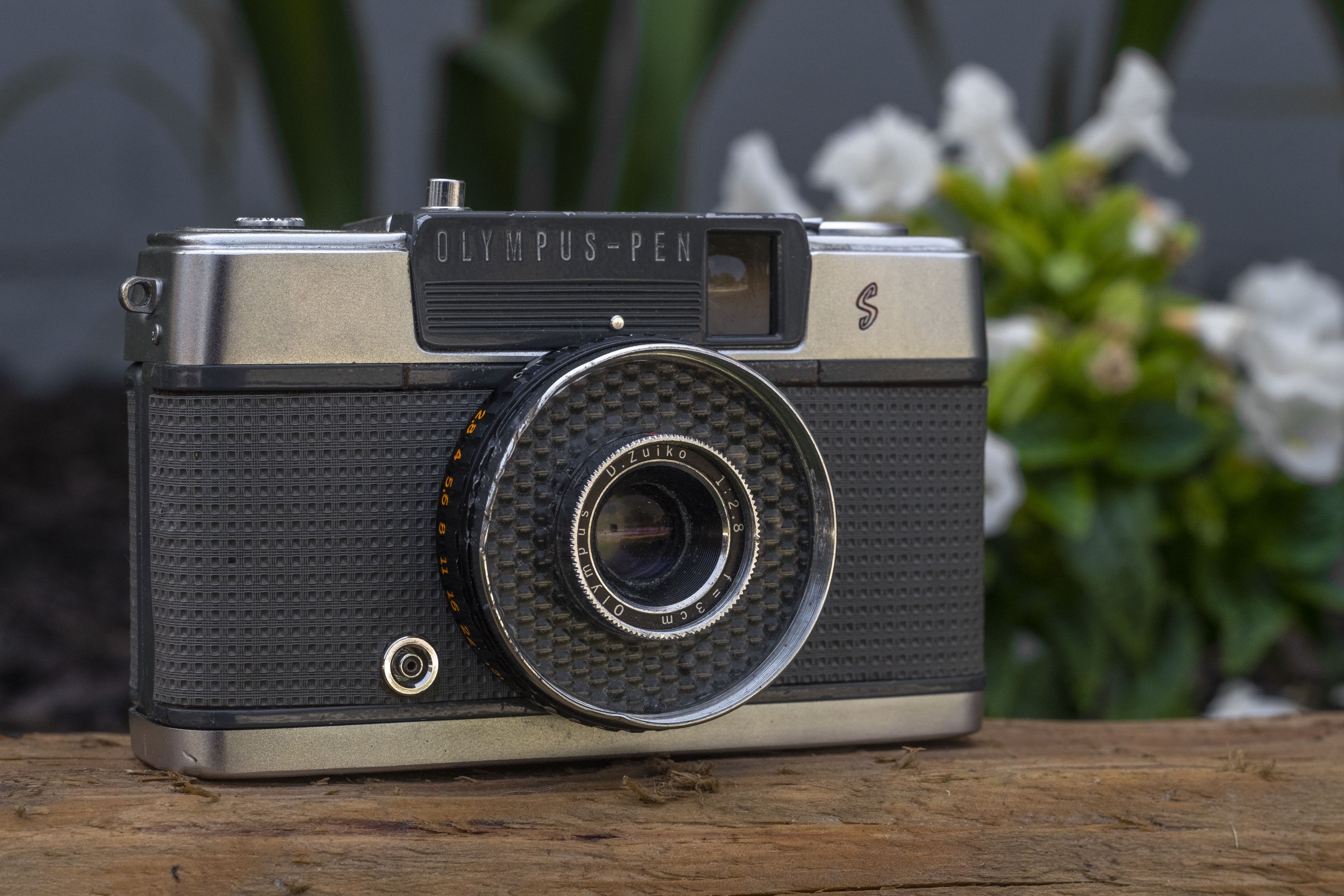
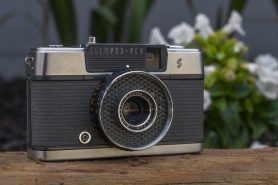
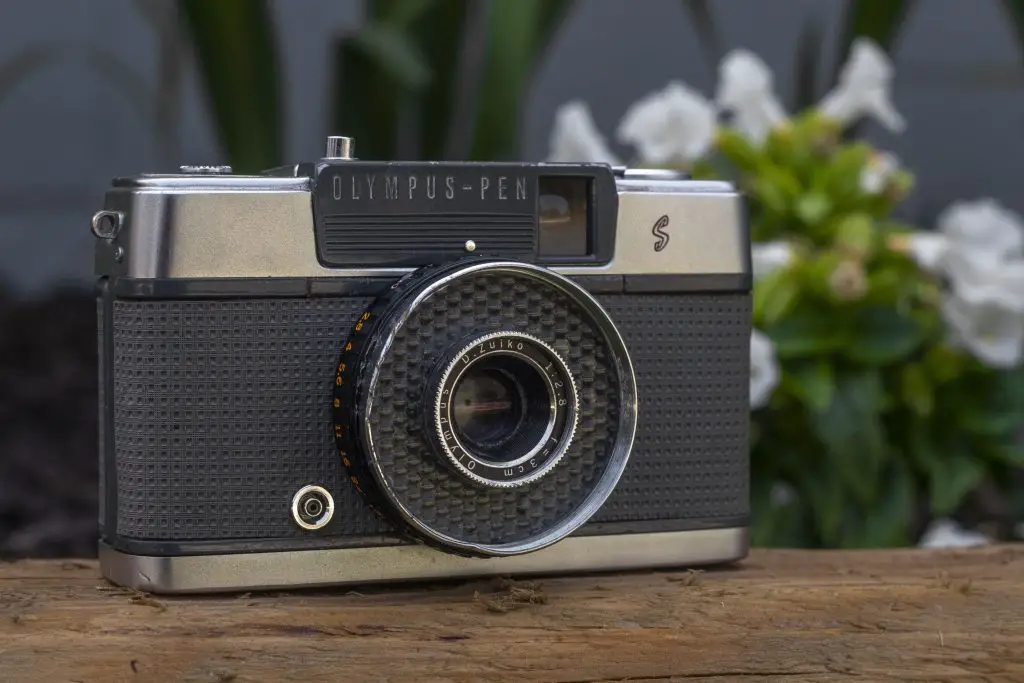
















I would totally second your recommendation about this camera. I picked one up for $10 thinking it wasn’t working, but it was set on Auto and the “red flag” was prohibiting the shutter from firing in the dark store. When I got outside, it worked with no issues. This is one of my favorite walk-about cameras, with a meter that still works, and settings that can support auto exposure down to 10ASA. The focus seems to be spot on, the images sharp, and the ergonomics are pretty much ideal in this easy user camera. Thanks for the review!
Thanks for the kind words! It’s amazing to me how often I’d paid a decent chunk of change for a highly desirable camera, only to feel underwhelmed, yet, I can find these types of “junk bin” cameras for very little and be so impressed with them! Like Forrest Gump said, “collecting cameras is like a box of chocolates, you never know what you’re going to get!”
Mike, you are blessed to have found one of these little gems with an accurate and working selenium meter. Re the lens: I understand that the letter preceding the Zuiko name tells us how many elements the lens has, with D = 4, F = 6, etc.
By George! I have never connected the dots that the first letter of the Zuiko lens was the number of elements it has! I knew that Minolta and Nikon both coded the lens element makeup into the model name of the lens, but I never considered that Olympus was doing it too! Very cool, Roger! I learned something new today. 🙂
I have no doubt that you could get an A4 print from that lens and possibly larger, but the format isn’t really suited to reversal films(transparencies) as I learned to my cost. I have an Olympus Pen FT which was probably Maitani’s (note spelling) greatest achievement.
Thanks for this review. Just picked one up mislabeled on eBay being sent from Japan. I thought I bought an ee for an OK price, but after purchasing realised the seller had not looked at the body and an S is boldly chiseled on the front and the lens is the better one. I think it is the early non easy load version making it a 62, one year older than me, but will check when it arrives. I intend to use it for triptychs in B&W and photos of classic car meets that I attend with a friend. How do you shoot 400 film in this?
I recently recovered an Olympus-Pen Rapid EE S, which is a little sister to this one. Even simpler, even smaller. But with Agfa Rapid cassettes. Only 3800 units were ever produced of that variant. I intended to give it a spin soon 🙂
The Rapid cassette Olympus cameras are just as good as the 35mm models, they just use a different type of film. You can actually reload Rapid cassettes with bulk 35mm film and it will work fine, just make sure not to put too much film in them or they’ll jam.